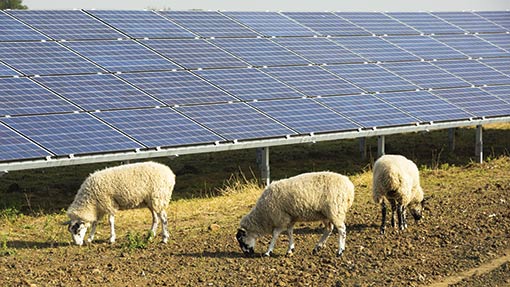Growth opportunities for farmers as solar up 60%

The total installed capacity of solar photovoltaics has increased by 60% over the past year, according to latest figures from the Department of Energy and Climate Change (Decc).
Some 3.5GW of generation capacity had been installed by the end of the first quarter this year, while the amount of electricity generated by solar was 77% higher in the first three months of 2014 compared with the same quarter last year, it said.
See also: Take care when choosing a solar developer
Solar recorded the biggest percentage increase in installed capacity of all technologies, mainly due to developers of larger projects rushing to get schemes commissioned ahead of the cut to Renewable Obligation (RO) support in April.
Solar Trade Association chief executive Paul Barwell said the figures illustrated how solar energy was crucial to meeting Britain’s future energy needs and warned that premature cuts to support, such as the proposed withdrawal of RO funding for solar farms larger than 5MW, meant more money would have to be spent finding costlier alternatives.
“The cost of solar has fallen by 65% since the coalition came to power. But if this government holds solar back, we risk losing momentum on cost reduction and job creation. We are close to being subsidy-free, all we need is one final push.”
Overall renewable energy accounted for nearly one-fifth (19.4%) of total electricity generation between January and 31 March, an increase of almost 7% on the same period in 2013, Decc said.
The biggest contributor remained onshore wind, accounting for 37% of renewable energy generation, with a further 24% from offshore wind. Bioenergy made up 25%, while that was followed by hydroelectricity (12%) and solar PV (1.6%).
The figures also showed the plant biomass sector, which includes energy from straw and energy crops, was the only sector to record a fall in installed generation capacity due to the closure of a plant at Tilbury last August.
That loss was offset by increased generation at Ironbridge and Drax, which resulted in an overall 25% increase in energy generation from plant biomass.
Decc said liquid biofuels represented 3.6% of petrol and diesel consumed in road transport in the first quarter of 2014.
Solar farms open their gates
Solar farms across England and Wales are opening to the public today (4 July) as part of an initiative by the Solar Trade Association (STA) to communicate the benefits of solar and the need for improved policy support.
The STA hopes to give visitors the chance to quiz solar developers about such projects and allow the industry to demonstrate how solar farms can improve the environment and help protect against rising energy costs.
“There’s a really positive story to be told about how benign, unobtrusive solar farms are quietly reducing our carbon emissions, boosting local biodiversity, helping farmers diversify their income, creating jobs and enhancing the UK’s energy security,” said STA chief executive Paul Barwell.
“We need to tell this story to counter the bad news stories resulting from a tiny minority of poor quality projects seized on gleefully by some newspapers and politicians.”
Click here for a list of participating farms.
